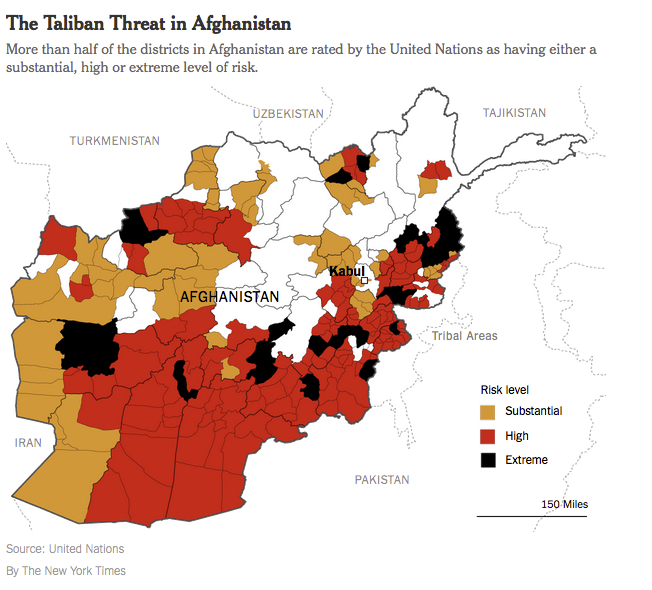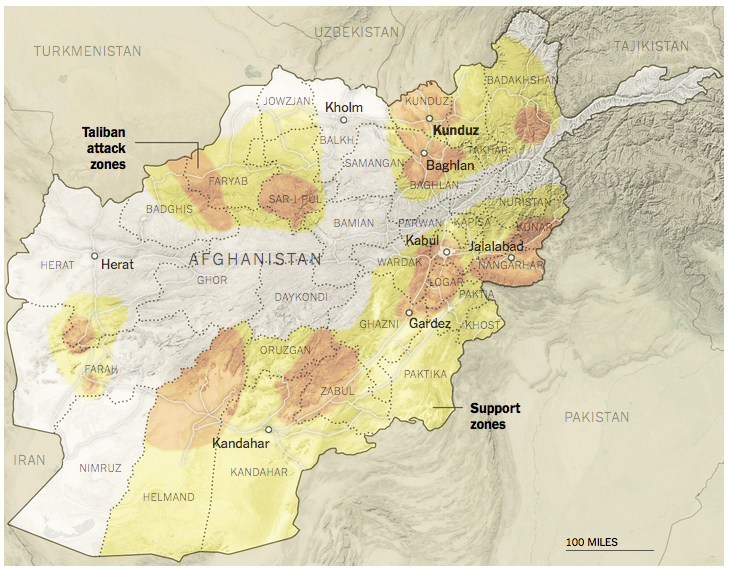http://www.nytimes.com/2015/10/12/world/asia/afghanistan-taliban-united-nations.html
OCT. 11, 2015
Afghan Taliban's Reach Is Widest Since 2001, U.N. Says
By ROD NORDLAND and JOSEPH GOLDSTEIN
KABUL, Afghanistan -- The Taliban insurgency has spread through more of Afghanistan than at any point since 2001, according to data compiled by the United Nations as well as interviews with numerous local officials in areas under threat.
In addition, the United Nations Assistance Mission in Afghanistan over the past two weeks has evacuated four of its 13 provincial offices around the country -- the most it has ever done for security reasons -- according to local officials in the affected areas.
The data, compiled in early September -- even before the latest surge in violence in northern Afghanistan -- showed that United Nations security officials had already rated the threat level in about half of the country's administrative districts as either "high" or "extreme," more than at any time since the American invasion ousted the Taliban in 2001.
That assessment, which has not been publicly released but is routinely shared by the United Nations with countries in the international coalition, appears at odds with the assessment of its American commander, Gen. John F. Campbell, in his testimony to Congress [1] last week.
"The Afghan security forces have displayed courage and resilience," General Campbell testified to the Senate Armed Services Committee on Tuesday. "They're still holding. The Afghan government retains control of Kabul, of Highway One, its provincial capitals and nearly all of the district centers."
Afghan officials in many districts currently under attack by the Taliban depict a significantly different situation. Even Highway One, a ring road connecting all of Afghanistan's main cities, has long suffered repeated Taliban ambushes and roadblocks in southern Afghanistan; over the past two weeks the insurgents repeatedly cut the highway in the Doshi and Baghlani Jadid districts of Baghlan Province -- long an uncontested government stronghold. Few government officials now use the highway along much of its route.
In many districts that are nominally under government control, like Musa Qala in Helmand Province and Charchino in Oruzgan Province, government forces hold only the government buildings in the district center and are under constant siege by the insurgents.
"We do not have any way to escape," said Wali Dad, the police chief in Charchino, where 400 police officers have been surrounded and pinned down for months. "If we get any means of escaping, I will not stay for a second in the district. The government is failing in their governing, and it's better to let the Taliban rule."
General Campbell testified that the Afghan security forces had "reversed almost all of the Taliban gains in northern Helmand after a considerable effort." He also said they had retaken Musa Qala and held on to other districts, like Sangin and Kajaki, that had been threatened in that area.
On Saturday, however, officials in Musa Qala said the government held only the district government compound, with no freedom of movement outside it because of Taliban threats.
"Only the government can enter the district center, and there are no government activities outside the district center," said Haji Mohammad Sharif, the district governor.
The United Nations data suggests that the tempo of the insurgency has increased in many parts of the country where there had been little Taliban presence in the past, including some areas in the north with scant Pashtun populations. The Taliban have been a largely Pashtun-based insurgency and have been historically strongest in Pashtun-majority areas in southern and eastern Afghanistan, with some pockets in the north, such as Kunduz.
"We have had fighting in 13 provinces of Afghanistan over the past six months, simultaneously," President Ashraf Ghani said this month in response to criticism after the fall of Kunduz.
All four of the United Nations provincial evacuations took place in northern Afghanistan. The United Nations evacuated all of its personnel and their families -- both Afghan and international staff -- from Kunduz as the Taliban overran that city on Sept. 28, and then a day later it evacuated its staff from Pul-i-Kumri, 60 miles to the south, in response to reports that the Taliban would attack there as well. The attack on Pul-i-Kumri never materialized, but similar fears over the safety of Faizabad, in Badakhshan Province in the far northeast, and in Maimana, the capital of Faryab Province in the northwest, subsequently led the United Nations to at least partly evacuate its staff and close some offices there, according to local officials.
A spokesman for the United Nations mission, Dominic Medley, would not explicitly confirm the four evacuations.
"We constantly review our operating environment, including taking steps such as the temporary reassignment of staff to different parts of Afghanistan," he said. "Staff from several locations, including Kunduz, have been relocated within the country."
Such evacuations have also led many aid groups to pull out of those communities.
The United Nations security threat rating system is also used by aid groups to guide their assessment of whether they can operate safely in provincial areas.
"It's much more difficult to access many areas in the north than before for aid agencies," said Fiona Gall, director of Acbar, an umbrella group representing nongovernmental organizations in Afghanistan. "It's a general degradation. It is very difficult to combat it in this environment."
The United Nations mission data showed that it considered about half of Afghanistan's districts to have a threat level considered high or extreme. United Nations personnel would not normally be allowed to travel to or through any district with a threat level that high. Districts with extreme threat levels either have no government presence at all, or a government presence reduced to only the district capital; there were 38 such districts scattered through 14 of the country's 34 provinces.
In all, 27 of Afghanistan's 34 provinces had some districts where the threat level was rated high or extreme.
In Oruzgan Province, in southern Afghanistan, four of its five districts were rated under extreme or high threat, with only the capital, Tarinkot, classified as under "substantial" threat. Many local officials predicted that the province might soon become the first to entirely fall to the Taliban.
"We had 570 policemen in Khas Oruzgan District, but now only 75 men remain and all in the district center; the rest have either been killed, surrendered or escaped," said Abdul Hameed, the deputy district governor. "We are still begging for survival, but we get no attention from the central government. If the situation remains the same, the district will fall to the hands of the Taliban."
Similar concerns were raised by officials in two other Oruzgan districts, Dehrawad and Chora. They all reported increased activity by the Taliban in recent months.
In Maimana, the capital of Faryab Province, American airstrikes, along with the arrival of pro-government militiamen, helped beat back the Taliban's effort to overrun the city last week, but the Taliban remain active in districts surrounding the provincial capital. Sayed Abdul Baqi Hashimi, a provincial council member from Maimana, said the United Nations had relocated its staff to Mazar-i-Sharif and shut down its activities in the city, but he said he thought it would be temporary.
"I believe our security forces have enough support from locals to defeat any advances made by the militants," he said.
Reporting was contributed by Taimoor Shah from Kandahar, Afghanistan; Alissa J. Rubin, Ahmad Shakib and Mujib Mashal from Kabul; and Najim Rahim from Kunduz, Afghanistan.
 http://www.nytimes.com/interactive/2015/09/29/world/middleeast/taliban-support-attack-zone-map.html
http://www.nytimes.com/interactive/2015/09/29/world/middleeast/taliban-support-attack-zone-map.html
SEPT. 29, 2015
Taliban Presence in Afghanistan
The Taliban took the northern city of Kunduz on Monday after a year of advancing toward the area. It is the first major city to fall to their control since 2001, but the insurgents continue to attack other areas throughout rural Afghanistan.

Sources: Institute for the Study of War
[1]
http://news.yahoo.com/senators-ask-us-general-troop-levels-afghanistan-071200449--politics.html
 http://www.nytimes.com/interactive/2015/09/29/world/middleeast/taliban-support-attack-zone-map.html
SEPT. 29, 2015
Taliban Presence in Afghanistan
The Taliban took the northern city of Kunduz on Monday after a year of advancing toward the area. It is the first major city to fall to their control since 2001, but the insurgents continue to attack other areas throughout rural Afghanistan.
http://www.nytimes.com/interactive/2015/09/29/world/middleeast/taliban-support-attack-zone-map.html
SEPT. 29, 2015
Taliban Presence in Afghanistan
The Taliban took the northern city of Kunduz on Monday after a year of advancing toward the area. It is the first major city to fall to their control since 2001, but the insurgents continue to attack other areas throughout rural Afghanistan.
 Sources: Institute for the Study of War
[1] http://news.yahoo.com/senators-ask-us-general-troop-levels-afghanistan-071200449--politics.html
Sources: Institute for the Study of War
[1] http://news.yahoo.com/senators-ask-us-general-troop-levels-afghanistan-071200449--politics.html